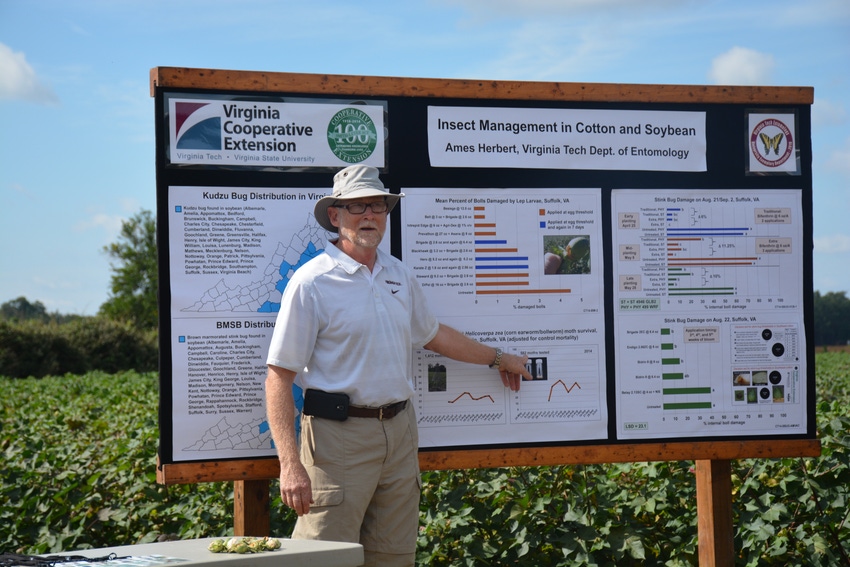
Stink bugs and kudzu bugs found in Virginia at much lower levels
Speaking at the pre-harvest field crops tour at the Tidewater Agricultural Research and Extension Center in Suffolk, Va. Sept. 11, Herbert said both pests showed up in a lot of counties across Virginia, but their populations were way down from the past two years. “What was different this year were the numbers. We found a few in a lot of fields but never many,” Herbert said.

Both the brown marmorated stink bug and the kudzu bug made an appearance in Virginia fields this year, but not at the same high levels as in previous years which is good news, according to Virginia Tech Entomologist Ames Herbert.
Speaking at the pre-harvest field crops tour at the Tidewater Agricultural Research and Extension Center in Suffolk, Va. Sept. 11, Herbert said both pests showed up in a lot of counties across Virginia, but their populations were way down from the past two years. “What was different this year were the numbers. We found a few in a lot of fields but never many,” Herbert said.
“We don’t know of any field that’s had to be treated for brown maramorated stink bugs in soybeans this year. Typically in the past two years in this area of the state, growers have had to treat fields. The populations were extremely late not only in soybeans, but also in the fruit crop and vegetable crops in the mid-Atlantic. Why? The only thing we can come up with was the cold winter that we had,” Herbert said.
“Kudzu bugs were much the same story. We found a few everywhere but not many anywhere. We know a few soybean growers sprayed for kudzu bugs but very few. Our survey is showing very low numbers.”
Herbert credits the cold winter for the lower population of kudzu bugs as well.
Still, brown marmorated stink bugs can prove to be a real pest in cotton. “Brown marmorated stink bugs will attack cotton if they get the opportunity and do a lot of damage. We’ve not found them in our cotton, but we know if they ever move in in large numbers they’ll be a problem,” he said.
Turning to bollworms in cotton, Herbert said bollworm pressure, like stink bug and kudzu bug pressure, was extremely light in Virginia this year. In a bollworm trial done at the research station, damage to cotton was less than 5 percent. “Some years it is as high as 30, 40 even 50 percent,” Herbert said.
“In general, the lowest boll damage was in our non-pyretheroids,” he said.
Turning to cotton diseases, Hillary Mehl, Virginia Tech disease control specialist, said the big problem in Virginia is always nematodes so the station has a number of trials looking at nematode control.
“We’ve been looking at different varieties for resistance to root knot nematodes,” Mehl said. “There is definitely a differenes in resistance and tolerance to root not nematodes with the different varieties. We actually see some varieties where there are high populations of root not nematodes, but they still yield well even in the presence of high nematode pressure.”
Meanwhile, Hunter Frame, Virginia Tech cotton specialist, provided a review of a study showing the relationship between varietal selection and plant growth regulators in conjunction with nitrogen management in cotton.
“We are evaluating four different plant growth regulator management strategies, two different nitrogen management strategies and three different variety maturities, an early, a mid and a full-season variety,” Frame said.
In part of the research, Frame used the plant growth regulator Pix applied at a low dose multiple times. “We made four trips with six ounces of Pix applied in each trip starting at match head square,” he said.
In another part of the study, Frame used a modified early bloom strategy where Pix was applied at early bloom and internode and plant height was measured. Frame said the modified early bloom plot did not receive a plant Pix treatment at match head square.
The study also looked at plant growth regulators applied at early bloom where 12 ounces of Pix were applied at early bloom alone. In the final part of the study, no plant growth regulators were applied.
In addition, Frame’s study examined the impact of different nitrogen management strategies on plant height. In one study a pre-plant of 20 pounds of nitrogen was applied along with a side-dress of 80 pounds of nitrogen for a total application of 100 pounds of nitrogen. Another study was a split side dress of nitrogen, where 40 pounds of nitrogen was applied at match head square with another 40 pounds applied at first flower.
“We examined late July plant height and what we saw was that the no-Pix had the highest plant height, the modified early bloom and early bloom had medium plant height and the low-rate multiple where eat that cotton early had the shortest plant height,” Frame said.
About the Author(s)
You May Also Like





